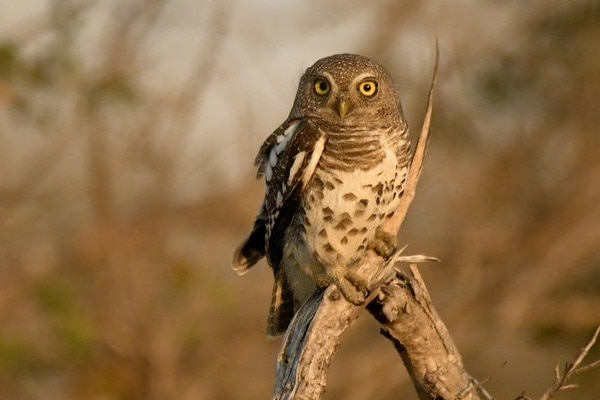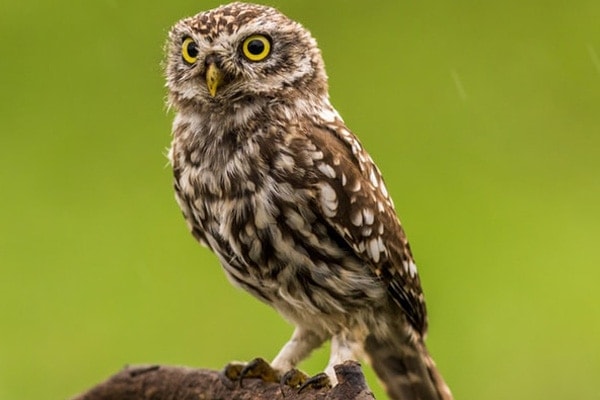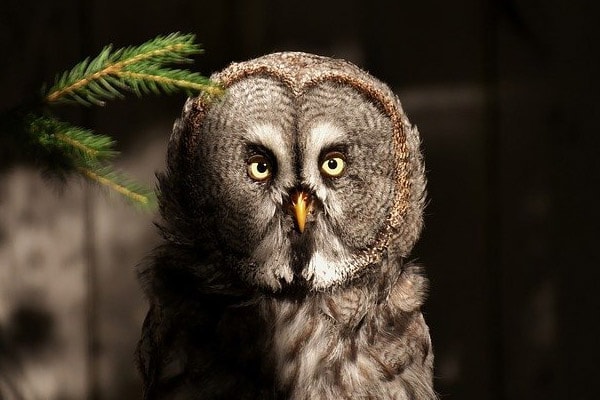Different birds create different sounds, and owls are known for their hooting. But as most owls are nocturnal, it’s still a wonder for most people why they hear owls hooting at sunrise and sunset.
Like many other birds, owls hoot for different reasons, including protecting their territory, during courtship, when they feel threatened, etc. The time of the day you hear an owl depends on the species. Although most owls are nocturnal, there are a few who are diurnal, allowing us to hear owl sounds even during the day.
In this article, I’m going to dive deeper into the question; “Why do owls hoot?”. We’ll discuss:
- Why owls hoot at sunrise and sunset
- Differentiating owl hoots
- When we can mostly hear owls
- Five common owls and their sounds
Now, let’s dive into the article…
Why Do Owls Hoot at Sunrise and Sunset?

According to statistics, there are three types of owls:
- Nocturnal: Active during the night
- Crepuscular: Active from dawn to dusk
- Diurnal: Active during the day
By looking at the color of owl eyes, you can tell what time of day it is generally active. Nocturnal owls are known to have black eyes, crepuscular owls have orange owls, and diurnal owls have yellow eyes. Out of the three, nocturnal owls have the most numbers, while diurnal owls have the least.
In other words, you can hear owls any time of the day. If it’s during the daytime, you may be hearing the diurnal owls. Below are a few of the diurnal owls:
Burrowing Owls
Burrowing owls breed on the southern border of the US and Mexico. These birds feature a brown back and wings with white spots and a white chest with brown spots. They have yellow eyes, which is common to diurnal birds.
These birds often live in open and treeless areas like grasslands, deserts, agricultural fields, and even in vacant lots in the cities.
Snowy Owls
Snowy Owls are found wintering in Alaska and Canada, while their breeding grounds are primarily in the Arctic. As the name implies, the snowy owls are pure white birds, with females having black spots around their backs, wings, and chest areas. They also feature a pair of yellow eyes.
Northern Pygmy-Owl

Northern Pygmy-Owls are tiny but ferocious daytime hunters. They are mostly found in the eastern parts of the US and some parts of Mexico. They feature a dark brown back with few white specks, a brown head with white spots, and a white chest with brown streaks. They also have a pair of yellow eyes.
Northern Hawk Owl
Northern Hawk Owls breed in Alaska in Canada. As the name implies, these birds’ behavior resembles a hawk – perching on top of trees and hunting in the daytime. Like other diurnal birds, they also feature a pair of yellow eyes.
Diurnal owls are pretty widespread, and it’s not uncommon that you hear them during the day and not only at night.
As for the reason why they hoot, owls are just like many small birds. They use tunes to communicate, and for owls, it’s hooting. They hoot to signify a couple of things:
- Courtship call
- Warning call
- Defense call
- Territorial call
The sound or hoot they produce would usually depend on what they want to say. And it’s actually easy to tell. Below, I’ll share how you can differentiate the different owl hoots:
Differentiating Owl Hoots
Territorial Calls
One of the reasons why owls hoot is to signify or claim territory.
During the breeding season, owls would go back to their breeding areas and look for finished nests made by other birds. Once they find one and claim it as their own home, they hoot to claim the territory so that other owls won’t come near it.
This call also sometimes helps attract females, telling them that they have found a nest.
Related Article: Buyer’s Guide For The Best Owl Nesting Boxes
Territorial owl calls differ for every species, but here’s how a barred owl’s territorial call sounds like:
Other owls territorial calls almost sound the same, too.
Related Article: Climate Change & Its Impact On Our Birds
Defense Calls
Owls also hoot as a way to defend themselves from predators.
Most of the time, before attacking, the owls would let out a loud screech or shriek to signify a threat to an attacker. They would continue to do this until the predator gives up and leaves their nest or territory.
Most of the time, they would also accompany this by spreading their wings to signify that they’re big.
Surprised or Threatened
When owls feel threatened or surprised, they sometimes let out a low-pitched sound that is almost similar to a dog’s bark. This serves as a warning to whoever is around them to just keep their distance.
Sometimes, they would also growl, snark, or snap their beaks to tell predators or enemies to stay away.
Here’s a Great Horned Owl letting out some warning barks:
Courtship Hooting
During the breeding season, owls hoot to look for their mates.
Males would let out territorial calls to keep other male owls away from their nests. They will then let out a courtship call and wait until a female owl hoots back with a higher-pitched hoot. This goes on back and forth until the female finds the male’s territory.
Screaming or Screeching
While most owls hoot, some owls communicate through screeching or screaming. This sometimes sounds like a woman screaming, which often alerts people, thinking there’s trouble. When the truth is, it’s just an owl.
Two owls known for screeching are eastern screech owls and western screech owls, which is where they got their name. Another owl you’ll hear with almost the same sound is a Barn owl.
When Will You Mostly Hear An Owl Hooting

Owls often make their first sound before they even hatch from the egg. As they grow, owls first develop a chirping sound. And as they grow, that’s when they practice vocalizing.
Males, in particular, practice their first hoots in the first winter. But as they mature, you’ll often hear their hooting sounds a lot during the breeding season as they attract mates.
As these are nocturnal birds, owls are often heard at night as soon as the sun sets. They’ll also often be heard right before the sun rises and before they go to bed. But of course, since some owls are diurnal, you would also hear them in the morning.
However, when you hear owls near your window, chances are, that’s not an owl.
Owls don’t hang around near windows. They are solitary creatures, and they don’t visit bird feeders. So, they would not most likely spend a lot of time near your window.
However, some birds are confident to be near your yard and resemble an owl’s sound. One particular bird is the Mourning Dove. For those who are not yet accustomed to an owl’s sound, it’s easy to mistake these birds’ sounds like that to an owl.
Listen closely to their call here:
If you close your eyes, you might mistake them for an owl. But it’s not.
Five Common Owls and Their Sounds
Now that you’re aware of why owls hoot let’s take a look at the five most common owls with very distinct calls.
1. Barred Owl
The Barred Owl’s call is very distinct. Most people describe it as a repeated “Who cooks for you? Who cooks for you?” Cute, right? Who would know that an owl can also act as our mother? They repeat the same phrase twice, prolonging the end of their second repetition.
2. Barn Owl
The Barn Owl is truly a beautiful owl known for its ghostly face. However, their sound can either surprise or scare you when you’re walking in the forest alone.
These birds can be heard with the “k-r-r-r-r-ick” sound to let their presence known to other owls. However, if it’s a distress call, it’s even longer.
3. Great Horned Owl
The Great Horned Owl is the largest owl in North America. As the name implies, these birds have two hornlike ears and can be very aggressive, hunting down birds and mammals larger than them.
However, despite the bird’s devilish looks, their hoot is not as scary. The birds let out a simple and rhythmic hooting that sounds like “hoo-h’HOO-hoo-hoo-hoo”. They use this sound as their territorial and mating call.
4. Burrowing Owl
The Burrowing Owl are medium-sized birds with a very high-pitched voice. It sounds like a simple and repetitive “coo-cooo, coo-cooo”. You might also hear a short wheezing at the end. To keep predators away from their nests, burrowing owls can sometimes mimic the sound of a rattlesnake to keep the enemies away.
5. Eastern Screech-Owl
As the name implies, eastern screech-owls are known for their screeching sound. This is a sound they often used when distressed. However, these birds also have other softer sounds like the trill, which requires them to only vibrate their voice box.
These birds are known to be impressive vocalists that use different vibrations and rhythms to create conversations.
Final Thoughts On Why Owls Hoot At Sunrise and Sunset
Owls hoot as a way to communicate, whether it’s to defend their territory, call out for a mate, protect themselves, and a lot more. But owls don’t just create a hooting sound. Owls can also scream, screech, whistle, bark, shriek, coo, hiss, and many more.
Regardless if it’s sunrise or sunset, owls can be heard at any time. This is because even if most owls are nocturnal, there are still many diurnal owls, too.
The post Why Do Owls Hoot At Sunrise & Sunset? appeared first on BirdInformer.com.
from BirdInformer.com https://ift.tt/2SS3RnZ

No comments:
Post a Comment